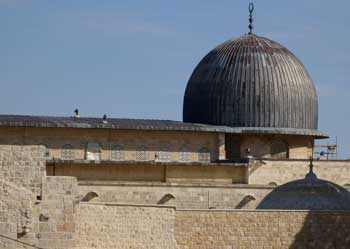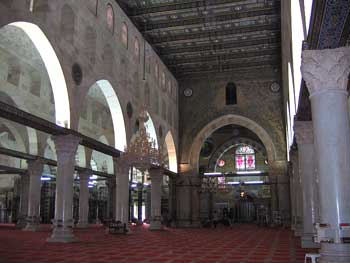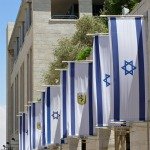Al Aqsa Mosque
The Al Aqsa Mosque sits atop the Temple Mount, where the Hall of Solomon, part of the Jewish Temple, once stood. It is the third most important mosque and one of the oldest in the world.
The mosque has been destroyed and rebuilt numerous times since it was first erected in the 8th century. Because it stands above the complex of vaults built by Herod, and not on solid ground, the mosque has been particularly vulnerable to earthquakes and was severely damaged in the 8th and 11th centuries. Very little remains of the original mosque and successive restorations were done in a hodgepodge of architectural styles.

For example the facade and porch of the building, which date to 1217, show a distinct Crusader style.
The present design of the building dates to 1036, when it was rebuilt following an earthquake. As impressive as it is now (and it can hold more than 5,000 worshipers), the Al Aksa Mosque is only half the size that it was prior to that time.
In 1099 the Crusaders conquered Jerusalem and used the mosque as a royal palace, adding various structures, including a church. In 1119, the Knights Templar turned it into their headquarters. They built the east and west annexes, which today house the Islamic museum and a women’s mosque, respectively.

Inside the Al Aqsa Mosque, the columns in the nave are made of Italian marble and were donated by Mussolini. The arch decorated with mosaic dates from 1036 – the mosaic was rediscovered in 1927, whereas the stucco decorations along the dome are of Mamluk additions.
The dome is an early example of Islamic architecture (unlike the dome of the Dome of the Rock, which is Byzantine). It was designed in 1036 and originally made of wood plated with lead enamel. In 1969, it was rebuilt of concrete and covered with anodized aluminum. In 1983, the aluminum was replaced with ribbed lead to match the original design. The dome’s interior decorations are from the 14th century.
The name al Aqsa (often also spelled al Aksa) comes from the Quran, which describes Muhammad’s night journey “to the temple that is most remote”, (al-masjid al-aqsa) from where he ascended to Heaven. The Quran never mentions Jerusalem, but Islamic tradition has come to associate it with this nocturnal journey.
For centuries, the term al-masjid al-aqsa was used by Muslims to refer to the entire Temple Mount. However, in the 16th century, it became known as the Noble Sanctary, with the name al Aksa reserved for the mosque itself.
For about 16 months, Muslims actually prayed in the direction of Jerusalem – as do the Jews – until Muhammad realized that the Jews would never accept his new religion or consider him a prophet, whereupon he taught his followers to pray toward Mecca.
In 1951, King Abdullah of Jordan was assassinated on the steps of the Al Aksa Mosque. In 1969, a Christian Australian tourist later determined to be mentally ill, set fire to the mosque in a bid to hasten the end of the world.
Understandably, security measures to ascend the Temple Mount to the Al Aqsa Mosque are very tight.
Access for non-Muslims is from the ramp to the right of the Western Wall only. Non-Muslims are also not allowed to pray, not even silently, anywhere on the Temple Mount.
Torah law forbids Jews from ascending the Temple Mount.
Modest dress required. Bring your passport and be prepared for strict security measures.
Open to non-Muslims Sun - Thurs 7:00 to 11:00, 13:30 to 14:30.
Return from Al Aqsa Mosque to Jerusalem Holy Sites.
Return to Muslim Quarter.
Return from Al Aqsa Mosque to Jerusalem Home page.
Traveler's Prayer
Our Gift to You!
Take us with you!
Only have a day or two in Jerusalem? Download our guidebook and make the most of your time here.
Introduction to Jerusalem: A Guide to the Holy City
"As we had limited time in Jerusalem, I purchased your mini guide book and found it very informative. Thanks!" - Brian, S. Africa
Top 5 Jerusalem Hotels
Click here for the top 5 discount hotels in Jerusalem.
Learn to Speak Hebrew:
Make Jerusalem part of your life:
Subscribe to our FREE newsletter.
Jerusalem Video
The 6-min virtual tour







New! Comments
Have your say about what you just read! Leave me a comment in the box below.